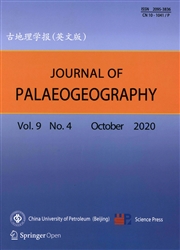A facies and palaeogeography-based approach for analysis of petroleum systems in United Arab Emirates
作者:Shu-Zheng Yin,Guo-Ping Bai,Lin Gao,Chuan-Yang Xu
摘要:The United Arab Emirates (UAE) is the 8th largest oil producing country and is rich in oil and gas resources. By the end of 2015, 68 oil and 23 gas fields had been discovered. The initial proved and probable (2P) oil, gas and condensate reserves amount to 81,135.9 MMb (million barrels), 192.09 Tcf (trillion cubic feet), and 6,496.58 MMb respectively, which are mostly reservoired in the Jurassic and Cretaceous carbonates. With the latest field data, this study attempts to document the salient features of petroleum systems in UAE. Based on depositional facies of source rock intervals, pods of source rocks were delineated. On the basis of an oil- and gas-source correlation, five known petroleum systems were identified and they are Lower Silurian-Upper Permian Khuff gas, northeast foreland Upper Jurassic-Lower Cretaceous gas, Upper Jurassic-Jurassic petroleum, Upper Jurassic/Lower Cretaceous-Lower Cretaceous composite petroleum, and Middle Cretaceous-Middle to Upper Cretaceous/Cenozoic petroleum systems. Of them, the Upper Jurassic/Lower Cretaceous-Lower Cretaceous composite petroleum system contains 73.2% of the total 2P reserves and thus it is the focus of this study. The Upper Jurassic and Lower Cretaceous source rocks consist of argillaceous limestone, mudstone and shale, which were deposited as intrashelf basin facies. The distribution of oil and gas in this system is controlled by the source kitchens and the regional evaporite seal.
发文机构:College of Geosciences
关键词:UAECARBONATEreservoirIntrashelfbasinPetroleumsystemEVAPORITESEAL
分类号: P[天文地球]
- Genus Pronephrium Presl 1851 (Thelypteridaceae) in Romania
- Ancient rip current records and their implications: an example from the Cretaceous Ukra Member, Kutch, India
- New freshwater plesiosaurian materials from the Middle Jurassic Xintiangou Formation of the Sichuan Basin, southwestern China
- First steps in reconstructing Early Jurassic sea water temperatures in the Andean Basin of northern Chile based on stable isotope analyses of oyster and brachiopod shells
- A facies and palaeogeography-based approach for analysis of petroleum systems in United Arab Emirates
- The complexity of climate reconstructions using the coexistence approach on Qinghai-Tibetan Plateau
- The use of mineral interfaces in sand-sized volcanic rock fragments to infer mechanical durability
- Fruits of Scirpus (Cyperaceae) from the early Miocene of Weichang,Hebei Province, North China and their palaeoecological and palaeobiogeographical implications
- Words of the Editor-in-Chief——some ideas about the comments and discussions of hyperpycnal flows and hyperpycnites
- Summary of Editorial Committee Meeting (January 5, 2020) of Journal of Palaeogeography


